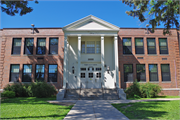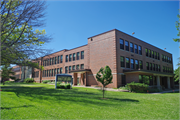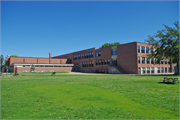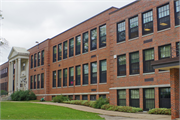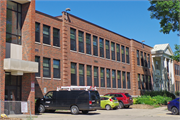Property Record
4201 BUCKEYE RD
Architecture and History Inventory
| Historic Name: | Frank Allis Elementary School |
|---|---|
| Other Name: | Frank Allis School |
| Contributing: | |
| Reference Number: | 95241 |
| Location (Address): | 4201 BUCKEYE RD |
|---|---|
| County: | Dane |
| City: | Madison |
| Township/Village: | |
| Unincorporated Community: | |
| Town: | |
| Range: | |
| Direction: | |
| Section: | |
| Quarter Section: | |
| Quarter/Quarter Section: |
| Year Built: | 1936 |
|---|---|
| Additions: | 1948 1952 1956 1960 |
| Survey Date: | 19832015 |
| Historic Use: | school – elem/middle/jr high/high |
| Architectural Style: | Colonial Revival/Georgian Revival |
| Structural System: | |
| Wall Material: | Brick |
| Architect: | Frank Riley |
| Other Buildings On Site: | |
| Demolished?: | No |
| Demolished Date: |
| National/State Register Listing Name: | Not listed |
|---|---|
| National Register Listing Date: | |
| State Register Listing Date: |
| Additional Information: | A 'site file' exists for this property. It contains additional information such as correspondence, newspaper clippings, or historical information. It is a public record and may be viewed in person at the Wisconsin Historical Society, State Historic Preservation Office. 2016- "The Frank Allis Elementary School is located on Buckeye Road between Jerome Street and Quaker Circle. The school's central, front entry faces Buckeye Road. A secondary entrance is located at the northwest end of the building adjacent to a parking lot accessed from Jerome Street. Behind the school, to the southwest, are playgrounds and a large, paved schoolyard. The remainder the school property to the southeast includes grass athletic fields and a garden. A noncontributing modern sign is located in the grass area between the school and Buckeye Road. Exterior The school building consists of a central brick-clad core constructed in 1936 with multiple brick additions dating from 1948 to 1960. The original school building on the property, a one-room brick Bungalow, opened in 1917. It was demolished in 1955 to allow for the construction of one of the additions. The two-story core features a Georgian Revival facade with a central two-story portico and decorative brick quoins at the building's corners. The portico includes a wood-sided pediment, plain entablature, and square columns with recessed panels. Three wood paneled doors, each with a threelight transom, provide entry to the school. An entablature over the doors reads "Frank Allis School." Above the entry on the second story is a window grouping consisting of a center eight-over-eight wood sash window and flanking four-over-four wood sash windows. To each side of the portico are four closely-spaced bays of eight-over-eight aluminum sash windows with stone sills. They replaced wood sash windows with the same eight-over-eight configuration in 1998-1999. A stone water table extends across the facade beneath the first floor windows. The west and east additions were constructed in 1948 and 1952, respectively. The additions match the appearance of the core section, including the brick quoins, eight-over-eight aluminum sash windows, and stone water table. The west addition is nine bays wide, while the east addition is 14 bays wide. Also in 1948, a combination gymnasium and auditorium was added to the rear of the building's core. The rectangular brick structure has a flat roof and no exterior details apart from brick pilasters. The school was expanded further to the west in 1956. With corner quoins and eight-over-eight windows, the design of the addition is largely compatible with the older sections of the building. Regrading in this location permitted a height of three stories. On the primary, Jerome Street side of the addition, the ground level features a flat-roofed projection with a recessed entryway supported by two square stone columns. Fifteen window bays, grouped in sets of five, are located in the second and third stories above the entryway. A second recessed entry is located on the north, Buckeye Road side of the addition, beneath a projecting flat roof supported by brick columns. Atop the roof is a diamond-patterned metal balustrade. In 1960 a three-story east addition was constructed. It features a modern design that deviates from the traditional look of the rest of the building. The Buckeye Road side of the addition consists of a full-height entry bay with heavy stone accents adjacent to a windowless brick wall. The southeast (side) elevation has pairs of six-over-six aluminum sash windows separated horizontally by stone panels and vertically by brick spandrel bands. The exterior appearance of the school has changed little since the last expansion in1960, apart from the aforementioned replacement windows. Interior The interior of the school conforms to a typical early to mid-twentieth century plan consisting of classrooms located on each side of a central lateral corridor connected to the front entrance by a short hall. The 1936 core retains some original interior details, including terrazzo floors, wood doors and trim work, and some slate chalkboards, built-in shelves, and cabinetry in the classrooms. Classroom doors are recessed within entryways with rounded corners. Hallways and rooms throughout the school have drop ceilings. Floors in the additions are covered in vinyl tile. Three rooms on the upper floor of the 1936 core were combined into one room that serves as the library The cafeteria is located in the basement of the school. The one-room gymnasium/auditorium features a brick stage and dado and exposed structural elements. A school first opened on this property in 1917 to serve a growing population in the town of Blooming Grove and evolved into its present form over the following four decades through new construction, additions, and modernizations. The most significant part of the school's history is its beginning, but the original one-room school building is no longer extant and no other physical elements remain from the first two decades of the school's existence. The adaptations of the school to the educational needs of the community from the 1930s to present day do not represent a significant event or trend within the context of education in the Madison area or greater Dane County. The core of the existing school was constructed in 1936 and features a restrained Georgian Revival design by Frank Riley, an influential Madison architect. It is a noticeably modest example of the Georgian Revival style, which was commonly employed for public buildings in the first decades of the twentieth century, and is also not a particularly exceptional example of Riley's work. Historical Overview At the time of its opening in 1917, the Frank Allis Elementary School was located in the town of Blooming Grove, a historically agricultural area directly east of Lake Monona. The town maintained a rural character into the twentieth century, before succumbing to urban growth. Between 1910 and 1920 manufacturing became the largest sector of Madison's economy and, as part of the "Madison Compromise" to allow the city to retain its identity as a university town and the state's capital, industrialization was limited to the east side. Due to its close proximity to the burgeoning factories and warehouses, Blooming Grove populated with laborers and their families. The City of Madison also began annexing portions of the town in efforts to expand its limits further and further east. Residential development near the site of the Frank Allis Elementary School began in the 1910s with developer E. C. Smith's Lake Edge Park subdivision. Home construction was slow at first, however, which Smith attributed to the lack of a nearby school and poor transportation: I would get people out and get them very much interested in property and almost invariably the question I dreaded would come up when they said: "Where do we send our children to school?" Then I had to admit that they had to send their children up the road over a mile to a one-room school, a one-teacher school (Nichols) ... Few people of today can realize the conditions of roads in those days. There were no paved roads ... A group of local residents sought to find an answer to the problem. The effort was led by Lew Porter, supervising architect of Wisconsin's capitol in Madison, who lived in the area near Lake Monona at the western end of Cottage Grove Road. After the group's proposal for a new school building was dismissed at a town meeting, they threatened to organize a school district of their own. The necessary signatures were obtained and School District Number 10 became a reality on October 16, 1915. E.C. Smith then approached the recently widowed Lillian Allis to acquire two acres of her land on the south side of Main Street (present-day Buckeye Road) for construction of the school. She agreed to gift the property, under the condition that the school be named after her late husband, Frank Allis, a noted Blooming Grove farmer who was the son of the founder of the Allis-Chalmers machinery company based in Milwaukee. Plans for the school were prepared by Lew Porter, who also supervised construction of the building free of cost. The one-room brick Bungalow was completed in 1917 and initial enrollment was 46. In the interim between creation of the district and the opening of the school, classes were held in a vacant house in the Lake Edge Park subdivision. Enrollment at the school steadily increased in the 1920s as the surrounding area developed, which prompted a series of building expansions. One-room additions were built in 1923 and 1925, and two more rooms were added in 1929. Each building addition was met with additions to the teaching staff. By the early 1930s enrollment reached 225, forcing the school to expand again. In 1936 a two-story, eight room building was constructed directly east of the original school. The red brick, Georgian Revival structure was designed by Frank M. Riley, a distinguished Madison architect best known for his Period Revival-style homes. Soon after the building's completion, enrollment climbed to over 400. The number of school-age children in the district spiked again as a result of the post-World War II baby boom. Further expansion of the school was necessary, which began in 1948 with additions to the 1936 structure, including a classroom wing to the west and a gymnasium/auditorium to the rear. An east wing was constructed in 1952, which added seven classrooms and a cafeteria. With an enrollment approaching 1,000, the school was still too small to meet the needs of the community, as some classes had to be held at the neighboring Lake Edge United Church of Christ and nearby Monona Grove High School. The original 1917 school building was subsequently torn down to allow for a large extension of the west wing to add ten classrooms, a kindergarten, and art and music rooms. The addition, completed in 1956, was designed by the Madison architectural firm of Siberz, Purcell & Cuthbert, who also designed the previous expansion projects in 1948 and 1952. Up to this point, the building additions conformed to the style of Riley's 1936 core (Lewis Siberz had previously been a partner of the architect). A final addition to the school was completed in 1960, adding classrooms to the east end of the building. Its modern design deviated from the look of the rest of the building. A period of decline for the school began in 1962 when its area of Blooming Grove was annexed to the City of Madison. Students were split between the Madison and Monona districts, which resulted in a severe drop in enrollment at the school. It nearly closed in the 1970s as a result, until the school board decided to house district offices there. Enrollment rebounded in the 1980s, after the school was included in a district desegregation plan that allowed it to accept students living south of Madison's Beltline. The student population has been stable over the past two decades. There were about 590 students in 1997 and 573 during the most recent school year (2014-15). Frank M. Riley Frank Morris Riley grew up in the town of Sun Prairie on the northeast side of Madison. He attended the University of Wisconsin before receiving a degree in architecture from the Massachusetts. Institute of Technology in 1908. He worked briefly for a Boston architect and spent multiple years studying in Europe, mostly in Germany and England. He returned to Madison at the onset of World War I. Riley's practice gained local prominence through his design of private residences. It is estimated that over 100 of his homes are located throughout Madison, particularly in the Shorewood Hills, University Heights, Lakewood, and Maple Bluff areas. According to Lucien S. Hanks, a former apprentice of Riley's and chairmen of the board of the Dane County Title Company, he was "the finest architect Madison had during the early 20th century" and "probably one of the first Madison architects to have a good background of study and really knew the basic principles of architecture and what was authentic, what was not." Riley was partial to Period Revival styles, especially Colonial Revival and Tudor Revival for his residential designs. In the opinion of Hanks, however, "Georgian was his favorite."16 Indeed, what could be considered Riley's most significant work evokes Georgian Revival influences, such as the Governor's Executive Residence (AHI #5409; formerly the Carl A. Johnson House), National Register-eligible Madison Club (AHI #28438), University of Wisconsin President's Residence (AHI #103003), and multiple houses within the National Register-listed Sherman Avenue Historic District. Other notable Riley-designed buildings in Madison include the National Register-listed First Church of Christ Scientist (AHI #16530), National Register-eligible East High School (AHI #1 02453), and several Period Revival-style fraternity and sorority houses on the campus of the University of Wisconsin. With a resume full of distinguished buildings, Riley's contribution to the city's architectural landscape was unquestionably significant." -"Frank Allis Elementary School", WisDOT 5992-09-40, Prepared by Greg Rainka (CCRG) for Strand Associates. (2015). 2015 - "The Frank Allis Elementary School consists of a central brick-clad core constructed in 1936 with multiple brick additions dating from 1948 to 1960. The original school building on the property, a one-room brick Bungalow, opened in 1917. It was demolished in 1955 to allow for the construction of a wing on the west side of the newer building the following year. The WHPD record for the property indicates Frank Riley was the architect of the 1936 portion of the current building, but this could not be confirmed through preliminary research. The exterior appearance of the school has changed little since the last addition in 1960. The interior could not be accessed at the time of survey because the school was not in session and closed to the public. The two-story core of the building features a Georgian Revival façade with a central portico and brick quoins. The portico includes a pediment, plain entablature, and square columns with recessed panels. Three wood paneled doors with transoms provide entry to the school. An entablature over the doors reads “Frank Allis School.” Above the entry on the second story is an eight-over-eight wood sash window with flanking four-over-four wood sash windows. To each side of the portico is an array of closely spaced eight-over-eight aluminum sash windows with stone sills. They replaced wood sash windows with the same eight-over-eight configuration in 1998-1999. The west and east additions were constructed in 1948 and 1952, respectively. The additions match the appearance of the core section, including the brick quoins, but are slightly shorter in overall height; as a result, they have smaller versions of the eight-over-eight aluminum sash windows. Also in 1948, a gym was constructed on the rear of the building’s core. It has few exterior details apart from brick pilasters. As noted above, a west wing was constructed in 1956. With corner quoins and eight-over-eight windows, its design is largely compatible with the older sections of the building. Regrading in this location permitted a height of three stories. The ground level features a flat-roofed projection with a stone-framed recessed entryway. In 1960 a three-story east wing was constructed with a modern design that deviates from the look of the rest of the building. It features a full-height entry bay with heavy stone accents adjacent to a windowless brick wall and a side elevation with pairs of six-over-six aluminum sash windows separated horizontally by stone panels and vertically by brick spandrel bands." |
|---|---|
| Bibliographic References: | Brinkman, Phil. “Allis Elementary’s Character Stands Solid Through 80 Years.” Wisconsin State Journal, December 12, 1997. Buenker, John D. The Progressive Era, 1893-1914. Madison, Wis.: Wisconsin Historical Society, 2013. Butterfield, C.W. History of Dane County, Wisconsin. Chicago: Western Historical Co., 1880. “Frank Allis School Has Interesting Growth Over Past 40 Years.” East Side News, February 23, 1956. “Frank M. Riley, Prominent Madison Architect and Builder, Dies at 73.” The Capital Times, May 24, 1949. Hendrickson, Mary. “Frank Allis Elementary School: A History in Progress.” Frank Allis Elementary School. Accessed June 17, 2015. https://allis.madison.k12.wi.us/history. Hone, Vivien. “Architect Riley’s Ability Benefits UW.” Wisconsin State Journal, February 8, 1966. Kreisman, Irvin. “Frank Allis School’s Tempestuous, But Proud, Story.” The Capital Times, January 12, 1963. Mclean, Doug. “Maple Bluff: Madison’s Beautiful North Shore Suburb.” Historic Madison: A Journal of the Four Lake Region 12 (1995). “School Profile.” Frank Allis Elementary School. Accessed September 2, 2015. https://allis.madison.k12.wi.us/files/profiles/allis-profile.pdf Wisconsin State Journal: June 19, 1936, p. 15 ("Bids for School Building"). |
| Wisconsin Architecture and History Inventory, State Historic Preservation Office, Wisconsin Historical Society, Madison, Wisconsin |

